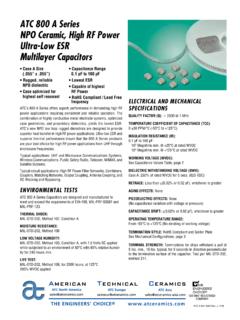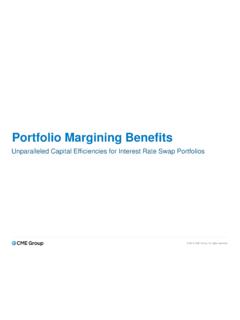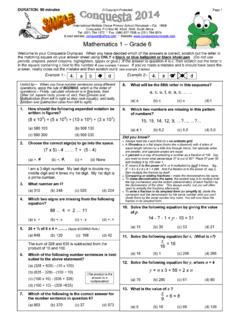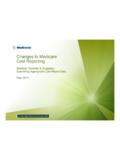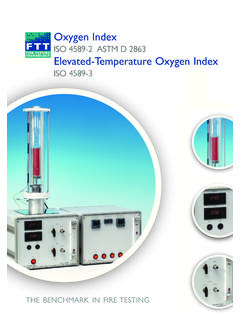Transcription of Practical Capacitor Tolerance Selection for …
1 Practical Capacitor Tolerance Selection for coupling , DCBlocking and Bypass Applicationsby Richard Fiore, Director of RF Applications Engineering, American Technical CeramicsProper Selection of suitable capacitortolerances is governed to a greatextent by the type of applicationunder consideration. This point shouldalways be taken into account when designingfor the best balance between cost and per-formance. For example, DC blocking, cou-pling and bypassing applications are not verysensitive to the variations in Capacitor valuethat are due to the choice of wide spread tol-erances. In contrast, applications such as fil-tering and matching will usually require nar-row spread capacitance tolerances in order tomeet the specific demands of those discussion will examine the impactof Capacitor Tolerance on overall circuit per-formance and will focus on DC blocking, coupling and bypassing electrical parameters such as theequivalent series resistance (ESR), seriesresonant frequency (FSR), magnitude of theimpedance (ZC), Capacitor RF current (IC),power dissipated by the Capacitor (PCD) andreflection coefficient ( ) will be 1illustrates the relationship betweenESR, FSR, and ZCfor selected capacitancevalues and tolerances.
2 All devices refer-enced therein are 100A series (55 mil by 55mil) porcelain chip capacitors . Table 1alsoshows the deviation from the nominalcapacitor impedance, in ohms, for varioustolerances and lists impedance deviationsfrom 50 ohms as a percentage for all capac-itance values designing capacitors into DC blockingand coupling applications, a suitable capaci-tance value must first be selected in order tomeet the primary requirements of the most essential Capacitor parameters toevaluate for these applications are series res-onant frequency (FSR), magnitude of imped-ance (ZC), and equivalent series resistance(ESR). A coupling Capacitor is best selectedso that its impedance is as low as possible atthe frequency of interest.
3 The impedancemagnitude at any frequency is easily calcu-lated as:Since the net reactance is zero at the capaci-tor s FSR, the total impedance will be equalto the ESR at this frequency. Therefore, theideal Capacitor intended for a coupling appli-cation will have an FSRthat corresponds tothe operating frequency. The Capacitor val-ues listed in Table 1are EIA standard valuesand tolerances. They have been deliberatelychosen to represent the nearest standard val-ues associated with common wireless fre-quency applications. All impedance data presented in Table 1is referenced to eachnominal Capacitor value. Likewise, the devi-ation in impedance from an ideal 50-ohmsystem has been tabulated as a following example describes a typicalcoupling application for a 20-watt (43 dBm) GHz single channel power current through the coupling Capacitor (IC) will be calculated for an ideal 50-ohm(50+j0) load impedance.
4 A 27 pF nominalcoupling Capacitor is used in the followingexample and is depicted as CCin Figure results obtained for the calculation ofpower dissipated (PCD) by the 27 pF cou-pling Capacitor will be used as a calculation will be repeated for the 27pF 10% Capacitor values and these resultswill be compared to the coupling Capacitor CCis in serieswith the load, the current flowing through CCand RLare equal and can be calculated by:Therefore the power dissipated by the capac-itor (PCD) is then calculated by:PCD= IC2x ESR Calculate PCDfor 27 pF nominalPCD= ( )2x = mW Calculate PCDfor 27 pF, 10%27 pF+10% = pF, PCD= ( )2x = mW27 pF-10% = pF, PCD= ( )2x = mWFrom this example it can be seen that thedifference in PCDbetween the nominal 27 pFvalue and the value corresponding to theworst case Tolerance ( pF) is about This corresponds to of the totalpower.
5 Even with the most stringent designrequirements imposed, the comparative dif-ference in PCDis infinitesimal and will notaffect the end performance of this circuit inany significant the same 27 pF Capacitor , a com-parison between the nominal capacitanceSeptember 2001Z = ESR2 + (XL-XC)2IC= or P/Z20/50 = TECHNICAL North PRODUCT DIGESTT able 1: Electrical Parameters for Select ATC 100A Series 55-mil x 55 mil Porcelain Chip CapacitorsCapacitanceESR FSRI mpedance Deviation of ZcDeviation of Zcand Tolerance (MHz) Magnitude Zcfrom nominal Zcfrom 50 ohm(Ohms) (Ohms) Network %Nominal ( pF) 3460 + pF ( pF) 3440 pF ( pF) 3490 ( pF) 3460 + pF ( pF) 3410 pF ( pF) 3520 ( pF) 3460 + 5% ( pF) 3380 5% ( pF) 3550 ( pF) 3460 + 10% ( pF) 3310 10% ( pF) 3640 (16 pF) 2410 + 1% ( pF) 2400 1% ( pF) 2420 (16 pF) 2410 + 2% ( pF) 2390 2% ( pF) 2430 (16 pF)
6 2410 + 5% ( pF) 2350 5% ( pF) 2470 (16 pF) 2410 + 10% ( pF) 2300 10% ( pF) 2530 (27 pF) 1870 + 1% ( pF) 1860 1% ( pF) 1880 (27 pF) 1870 + 2% ( pF) 1860 2% ( pF) 1890 (27 pF) 1870 + 5% ( pF) 1830 5% ( pF) 1920 (27 pF) 1870 + 10% ( pF) 1790 10% ( pF) 1970 (100 pF) 1000 + 1% (101 pF) 1000 1% (99 pF) 1000 (100 pF) 1000 + 2% (102 pF) 990 2% (98 pF) 1010 (100 pF) 1000 + 5% (105 pF) 980 5% (95 pF) 1020 (100 pF) 1000 + 10% (110 pF) 960 10% (90 pF) 1050 PRODUCT DIGESTand output match will be that the match is ideal, the reflec-tion coefficient ( ) resulting from the mis-match losses associated with the couplingcapacitor will be calculated.
7 The calculationwill be performed for the nominal 27 pFvalue as well as the 10% Tolerance the value of the VSWR and returnloss is ascertained for both the nominalcapacitor value as well as for the 10% Capacitor reflection coefficient will be calculat-ed in reference to a 50-ohm system. Themagnitude of impedance for the 27 pF capac-itor will be denoted as ZCin this Characteristic shunt impedance (50 ohms)ZC= Capacitor impedance (ohms)ZX= Z0+ ZC(ohms)Reflection coefficient ( )VSWR and Return LossReturn Loss RL = 20 Log Match calculations for 27 pF nominalZC= ohm Therefore = = = = : Loss = 20 Log = dB Match calculations for pF (+10% value)ZC= ohmTherefore = / = = = : Loss = 20 Log dB Match calculations for pF (-10% value)ZC= ohmTherefore = / = = = : Loss = 20 Log dBVDDFETCB1CB0 LMATCHINGNETWORKCAPACITORIMPEDANCECAPACI TORIMPEDANCE =Zx /Zo -1Zx / Zo +1 VSWR = 1 + r 1 - rFigure 3.
8 GHz Amplifier Output Bias NetworkFigure 2: Block Diagram of Amplifier Output Coupled to 50 ohm LoadFigure 1: Capacitor CcCoupling ApplicationSEPTEMBER PRODUCT DIGESTT able 2is a summary of the results of allmatch calculations. From these calculations itis clear that the effect of capacitance toleranceis minimal on the magnitude of the imped-ance and reflection coefficient. In the worstcase, the VSWR is :1 as compared :1 for the nominal 27 pF Capacitor . Thedifferences stated here are also very small andwill not affect the output match or end per-formance in any significant function of a bypass Capacitor is to offer alow impedance RF path to ground. Accordingly,the Capacitor s net impedance will be the mainconsideration for bypass applications.
9 In thefollowing example CB0is used to suppress GHz carrier frequency energy, while CB1will serve to suppress RF energy below thecarrier frequencies around 1 GHz. In an actu-al design there would generally be additionalbypass capacitors used in the output bias net-work to facilitate extended bypass frequencycoverage below the carrier frequency. In addi-tion to suppressing RF energy generated bythe amplifier from appearing on the VDDsup-ply line, bypass capacitors will also suppressnoise generated by a switch mode power sup-ply (SMPS) so that it doesn t appear on thedrain of the transistor. The noise generated byswitching pulse edges from an SMPS is con-tinuous and can occur up to frequencies equalto , where PEis the pulse edge dura-tion in seconds.
10 This noise may be in the rangeof several hundred MHz requiring largercapacitance values to decouple it from theVDDsupply 3depicts a GHz amplifier out-put bias network denoting the CB0and CB1bypass capacitors . The selected values for CB0and CB1are 27 pF and 100 pF values were chosen because they arethe nearest standard EIA Capacitor value withFSR s closely matching the frequencies ofinterest. Referring to Table 1it can be seenthat a 27 pF nominal Capacitor has an imped-ance of ohms at this fre-quency corresponds to the Capacitor s FSR,the net reactance is zero and therefore theimpedance is made up entirely of ESR. Theimpedance for the worst-case Capacitor toler-ances of 10%, corresponding to values pF and pF, is ohms and at GHz respectively.








